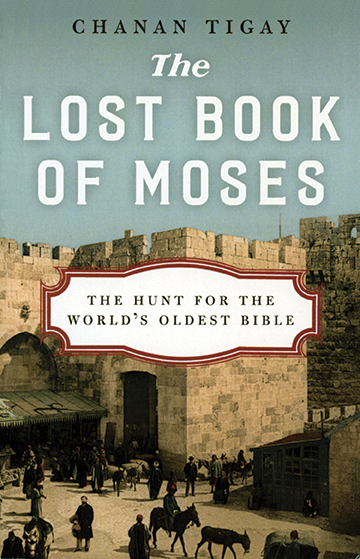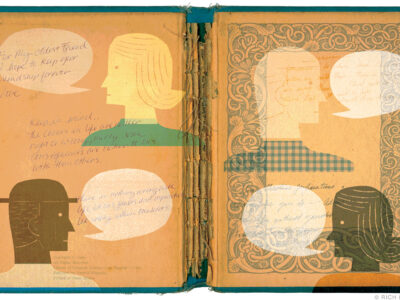Was an antiquities dealer’s pre-Biblical scroll authentic after all?

The Hunt for the World’s Oldest Bible
By Chanan Tigay C’98
Ecco, 2016, $27.99.
By Dennis Drabelle | I still remember the eye-opening day my seventh-grade teacher drew our attention to the information available at the front and back of a book: the printing history, for example; whether any portions of the book had first appeared in newspapers or magazines; and the acknowledgments page, which might tell how and where the author did her research. A book contains information about its provenance, Mrs. Krull was pointing out, and we shouldn’t skip over this.
Clues to a book or manuscript’s bloodline become more important when the item is old and rare—and downright compelling when it’s the Bible. The “hunt” chronicled in Chanan Tigay’s spirited new book is for the truth about an alleged primal version of Deuteronomy, the fifth book of the Hebrew Bible (the Old Testament, in Christian parlance), the one in which Moses prepares the Children of Israel for their entry into the Promised Land.
Tigay’s protagonist is a Moses himself: Moses Wilhelm Shapira, a Polish-born Jew who converted to Christianity and emigrated to Jerusalem, where he became a dealer in Biblical antiquities, catering to museums and the Christian tourist trade. In the early 1870s, he got hold of inscribed stone fragments bearing a resemblance to a recently discovered stele (inscribed stone slab) popularly known as the Moabite Stone.
Now in the Louvre, the Moabite Stone narrates the Moabites’ rebellion against Israel. The stone’s value lay in its being, in Tigay’s words, “the first confirmation of a Biblical story from outside the Holy Book itself” (albeit in a somewhat different version from that in the Book of Kings). “In the late nineteenth century,” Tigay notes, “archaeology was still a fledgling science, and the idea that its practitioners could find hard evidence for the biblical version of history fired the public’s imagination.”
Shapira sold some of these fragments only to have them exposed as fakes by a French archaeologist named Charles Clermont-Ganneau. Shapira claimed innocence—he was a dealer, not a scholar, and the blame should go to his Bedouin supplier—but his reputation had taken a hit.
A decade later, he came into possession of something he counted on both to restore his good name and make his fortune: that alternative, earlier version of Deuteronomy, inscribed on a scroll made of leather. If genuine, this find could shake up both Judaism and Christianity, undermining acceptance of the standard Bible as the fixed-for-all-time word of God.
But just as Shapira was hoping to sell the scroll to the British Museum for a whopping million pounds, down swooped the persistent Ganneau, who argued strenuously that Shapira was peddling a clever forgery. Ganneau’s view prevailed. The British Museum backed off, and in 1884 Shapira shot himself to death.
In a list of dramatis personae at the front of the book, Tigay identifies Ganneau as “Shapira’s nemesis,” and the Frenchman’s obvious contempt for the dealer is one of the reasons why Tigay came to wonder if Shapira had been treated unfairly—if, in other words, the scroll might be legitimate after all, a precursor to the Dead Sea scrolls that came to light starting in 1946. The best way to find out would be to track down the artifact itself and see what might be gleaned from its physical and textual properties. Tigay’s efforts to follow the scroll’s long and tortuous post-Shapira trail lie at the heart of The Lost Book of Moses.
For the most part, it’s an exciting quest indeed, taking the author to England, Holland, Jerusalem, and even Australia. At times, Tigay’s injection of himself into the action is strained. Few readers, for example, will want to join the author’s internal debate on whether to opt for a more flattering retake of his photo ID at the British Library. And his then-and-now narrative style—a chapter set in the 19th century, followed by the next installment of his own globetrotting adventures—can make the storyline hard to follow at times. But the theatrics pay off in the book’s suspenseful second half, when Tigay, who lives and works in the Bay Area (he teaches writing at San Francisco State), begins to suspect that the answers he’s looking for might be housed in an archive right down the street.
He can also be quite funny, as when he’s shown around a room in England that, he’s just found out, can’t possibly contain anything of use to him; “and yet, so that [his guide] wouldn’t feel I’d wasted her time, I strutted around … like Hercule Poirot, glancing behind the TV and the bed and the nightstand until, satisfied that a thorough search had been completed, I nodded to the door.” In discussing one biblical scholar’s mistranslation of God “getting angry” as God “committing adultery,” Tigay quips that the error “can only leave one wondering, Who’s the lucky lady?”
Tigay’s father is the well-known rabbinical scholar (and emeritus Penn professor) Jeffrey H. Tigay. The son’s deep knowledge of Jewish tradition serves him well; he is also at ease with Christian doctrine and practice, as well as respectful of Shapira’s conversion. As for the ultimate verdict on Shapira, let me say only that Tigay renders it clearly and convincingly. Accompanying him to his conclusion is a journey worth taking.
Dennis Drabelle G’66 L’69 is a former editor at The Washington Post Book World.




